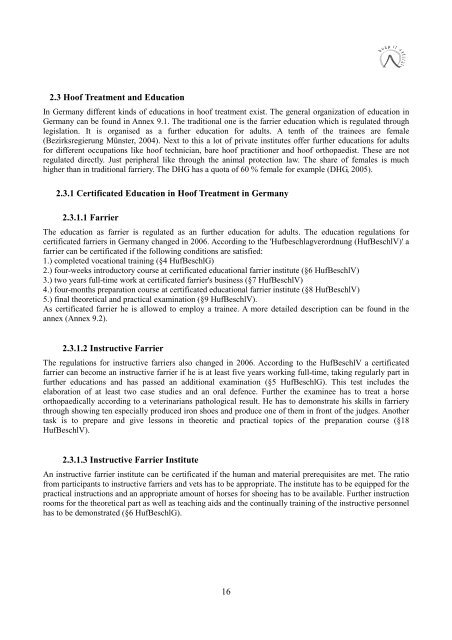Bachelor Thesis - Christina Kuenen - Hufpfleger
Bachelor Thesis - Christina Kuenen - Hufpfleger
Bachelor Thesis - Christina Kuenen - Hufpfleger
You also want an ePaper? Increase the reach of your titles
YUMPU automatically turns print PDFs into web optimized ePapers that Google loves.
2.3 Hoof Treatment and Education<br />
In Germany different kinds of educations in hoof treatment exist. The general organization of education in<br />
Germany can be found in Annex 9.1. The traditional one is the farrier education which is regulated through<br />
legislation. It is organised as a further education for adults. A tenth of the trainees are female<br />
(Bezirksregierung Münster, 2004). Next to this a lot of private institutes offer further educations for adults<br />
for different occupations like hoof technician, bare hoof practitioner and hoof orthopaedist. These are not<br />
regulated directly. Just peripheral like through the animal protection law. The share of females is much<br />
higher than in traditional farriery. The DHG has a quota of 60 % female for example (DHG, 2005).<br />
2.3.1 Certificated Education in Hoof Treatment in Germany<br />
2.3.1.1 Farrier<br />
The education as farrier is regulated as an further education for adults. The education regulations for<br />
certificated farriers in Germany changed in 2006. According to the 'Hufbeschlagverordnung (HufBeschlV)' a<br />
farrier can be certificated if the following conditions are satisfied:<br />
1.) completed vocational training (§4 HufBeschlG)<br />
2.) four-weeks introductory course at certificated educational farrier institute (§6 HufBeschlV)<br />
3.) two years full-time work at certificated farrier's business (§7 HufBeschlV)<br />
4.) four-months preparation course at certificated educational farrier institute (§8 HufBeschlV)<br />
5.) final theoretical and practical examination (§9 HufBeschlV).<br />
As certificated farrier he is allowed to employ a trainee. A more detailed description can be found in the<br />
annex (Annex 9.2).<br />
2.3.1.2 Instructive Farrier<br />
The regulations for instructive farriers also changed in 2006. According to the HufBeschlV a certificated<br />
farrier can become an instructive farrier if he is at least five years working full-time, taking regularly part in<br />
further educations and has passed an additional examination (§5 HufBeschlG). This test includes the<br />
elaboration of at least two case studies and an oral defence. Further the examinee has to treat a horse<br />
orthopaedically according to a veterinarians pathological result. He has to demonstrate his skills in farriery<br />
through showing ten especially produced iron shoes and produce one of them in front of the judges. Another<br />
task is to prepare and give lessons in theoretic and practical topics of the preparation course (§18<br />
HufBeschlV).<br />
2.3.1.3 Instructive Farrier Institute<br />
An instructive farrier institute can be certificated if the human and material prerequisites are met. The ratio<br />
from participants to instructive farriers and vets has to be appropriate. The institute has to be equipped for the<br />
practical instructions and an appropriate amount of horses for shoeing has to be available. Further instruction<br />
rooms for the theoretical part as well as teaching aids and the continually training of the instructive personnel<br />
has to be demonstrated (§6 HufBeschlG).<br />
16


